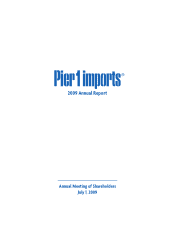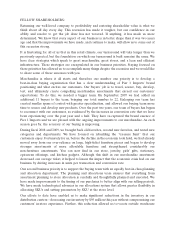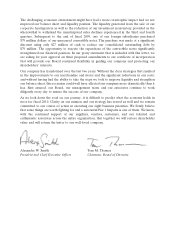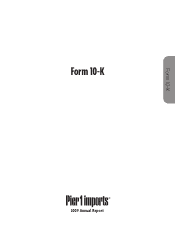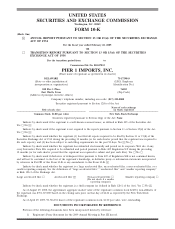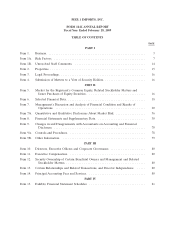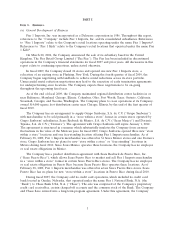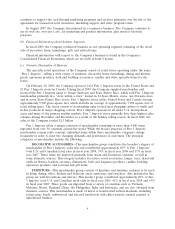Pier 1 2009 Annual Report Download - page 4
Download and view the complete annual report
Please find page 4 of the 2009 Pier 1 annual report below. You can navigate through the pages in the report by either clicking on the pages listed below, or by using the keyword search tool below to find specific information within the annual report.space of 350,000 square feet in fiscal 2009, and to close our Chicago distribution center in the
first quarter of fiscal 2010.
The third business priority is to tighten up the supply chain from vendors to our stores to reduce
both costs and lead times. We have made changes to consolidation, renegotiated ocean freight
contracts and improved vendor compliance. To improve our supply chain domestically, we
established a West Coast transload facility that both reduced cost and improved domestic transit
times. In our distribution centers, we reduced labor costs by implementing a labor package on
engineered standards that increased productivity. Additionally we reduced management layers,
which reduced fixed labor costs. To further these efforts, we developed a store delivery schedule
matrix that allows us to flex from two deliveries each week back to one delivery based on changes
in sales volume. The supply chain changes that we have made both internationally and
domestically helped us to offset the high fuel prices and inflationary pressures experienced in
2008 and to position us to improve merchandise margins in fiscal 2010.
We are extremely cost conscious, and so our fourth business priority is to make the business more
lean and efficient in every way. In fiscal 2008, we refocused the organization on the success of our
Pier 1 Imports stores. This meant exiting all non-core businesses. We eliminated the e-commerce
business, the catalog business, and the clearance stores and closed the Pier 1 Kids concept. We
are now totally focused on our core business—the Pier 1 Imports retail stores.
We have taken significant costs out of the business, reducing overall SG&A by approximately
$190 million from fiscal 2007. The permanent savings resulted from decreases in marketing
spend, payroll, and other general administrative costs. We have significantly reduced our IT costs
and at the same time leveraged technology to increase the efficiency and effectiveness of our
business without compromising customer service and quality. In fiscal 2010 we will be able to
reduce costs even more through continued technological and process improvements without
increasing the size of our IT footprint.
The fifth business priority is to develop real estate strategies that protect both the short- and
long-term future of our Company. We are the only home specialty global importer with a
nationwide network of stores. We believe this is a competitive advantage and will maintain it.
However, we had a few more stores than needed to give us good coverage. In February 2007, the
Company had over 1,200 stores in its North American chain. Since that time, we have closed
119 locations and opened only five. We judiciously review opportunities to improve the efficiency
of our store network through economic terminations, natural expirations and renewal options.
Since the economy weakened, we have taken the opportunity to negotiate with our landlords to
achieve rental reductions which would improve profitability. We are pleased with the support we
have received from our landlord community and have agreed to roughly $7 million in rental
savings for the upcoming fiscal year. We will continue working with our landlords through fiscal
2010 and expect to achieve additional savings.
We concluded in the summer of 2007 that we should sell our headquarters building. In June
2008, we completed the sale to Chesapeake Energy Corporation for approximately $100 million.
This sale had a positive impact on both our balance sheet and liquidity. We now lease
approximately half of the building on a seven year lease.
Our sixth business priority is to ensure that our marketing creates a balance between bringing
customers to our stores in the short term and building our brand for the long term. Initially, we
reduced our marketing spend by eliminating marketing efforts that were not providing a return

